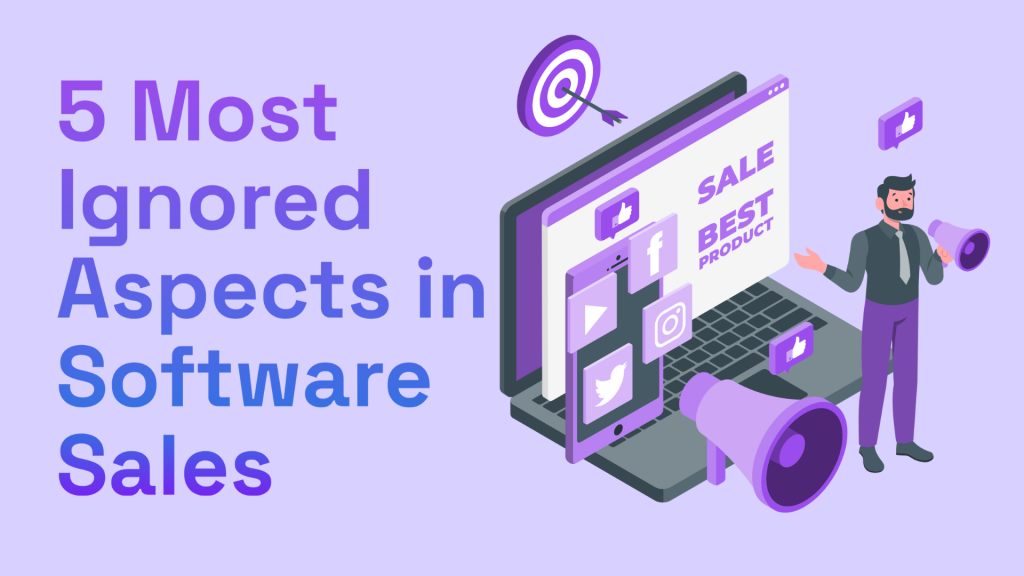
Introduction
The software industry is growing rapidly, with global software revenues expected to surpass $1.4 trillion by 2025. However, despite this booming market, many software companies struggle with sales. While pricing, marketing, and product features often take center stage, some critical aspects of software sales are frequently overlooked.
Ignoring these elements can lead to lost deals, increased customer churn, and poor long-term business growth. In this blog, we’ll uncover five commonly ignored aspects in software sales and how addressing them can help companies boost revenue and customer satisfaction.
1. Understanding the Customer’s Pain Points
One of the biggest mistakes in software sales is focusing too much on the product rather than the problems it solves. Sales teams often rely on pre-scripted pitches and generic feature lists, assuming the software’s capabilities will impress customers.
- Why this is a problem:
o Not all customers have the same challenges.
o A one-size-fits-all pitch fails to connect with buyers.
o Customers buy solutions, not just software.
- What to do instead:
o Conduct discovery calls to understand customer pain points.
o Customize your sales pitch based on the specific needs of each prospect.
o Use case studies and real-world examples to show how your software solves problems.
Example: A SaaS company selling CRM software saw a 25% increase in conversions after shifting from a feature-based sales pitch to a problem-solving approach tailored to each client’s industry.
2. The Role of After-Sales Support & Customer Success
Many software sales teams consider their job done once the deal is closed. However, failing to support customers post-purchase can lead to low retention rates and poor brand reputation.
- Why this is a problem:
o Customers need training and onboarding to use the software effectively.
o Poor post-sale support increases churn.
o 86% of customers say good customer service turns them into repeat buyers (HubSpot).
- What to do instead:
o Offer personalized onboarding to ensure customers get value from the software.
o Provide proactive customer success teams to assist clients before they experience issues.
o Use automated check-ins and feedback loops to track customer satisfaction.
Example: A cloud security software provider reduced churn by 40% by implementing a structured onboarding process with dedicated account managers.
3. Value-Based Selling Over Feature Dumping
Sales reps often get excited about product features and overwhelm prospects with technical jargon and long lists of functionalities. However, customers don’t care about how many features your software has—they care about how it benefits them.
- Why this is a problem:
o Too many features can confuse and overwhelm buyers.
o Customers may not see how features translate into actual value.
o A feature-focused pitch can lead to price objections.
- What to do instead:
o Sell outcomes, not just features. Instead of saying, “Our software has AI-powered automation,” say, “Our software reduces manual work by 40%.”
o Highlight ROI (Return on Investment) by explaining how the software saves time, reduces costs, or increases efficiency.
o Use real-world scenarios to show how the software solves problems.
Example: A project management software company increased sales by 30% after shifting from a feature-focused sales approach to a value-driven sales strategy that emphasized productivity gains for businesses.
4. Leveraging Data and Customer Insights
Many software sales teams fail to use data effectively, relying on guesswork instead of insights. By leveraging customer analytics, CRM data, and behavioral insights, companies can make smarter sales decisions.
- Why this is a problem:
o Sales teams miss cross-sell and upsell opportunities.
o Lack of customer insights leads to poor engagement strategies.
o Decisions based on intuition rather than data are less effective.
- What to do instead:
o Use CRM tools to track customer interactions and preferences.
o Implement predictive analytics to identify high-potential leads.
o Use data-driven personalization to tailor offers based on customer behavior.
Example: A subscription-based software company boosted revenue by 22% by using customer data to identify the best time to offer upgrade recommendations.
5. Building Long-Term Relationships vs. One-Time Deals
Many software sales teams focus on closing the deal rather than nurturing long-term relationships. However, retaining existing customers is 5x cheaper than acquiring new ones.
- Why this is a problem:
o Overemphasis on new sales leads to high customer churn.
o Companies miss opportunities to increase lifetime value (LTV).
o Poor relationship management leads to negative word-of-mouth.
- What to do instead:
o Prioritize customer engagement and relationship-building.
o Offer loyalty programs, exclusive webinars, and value-added services.
o Encourage referrals and testimonials from satisfied clients.
Example: A software company increased referrals by 50% after introducing a loyalty program rewarding long-term customers with discounts and early access to new features.
Conclusion
Software sales require more than just a great product and a strong pitch. Understanding customer pain points, providing excellent post-sales support, focusing on value rather than features, using data effectively, and building long-term relationships is crucial for sustained success.
By addressing these five often-ignored aspects, software companies can not only boost their conversion rates but also improve customer satisfaction and retention.
Now it’s your turn! Are there any other overlooked factors in software sales that you’ve noticed?
Share your thoughts in the comments!
